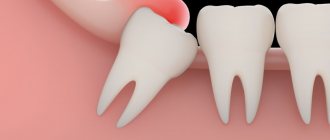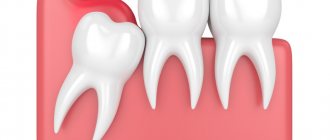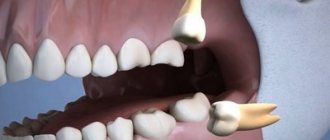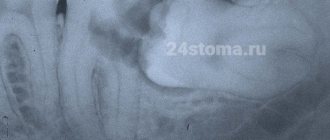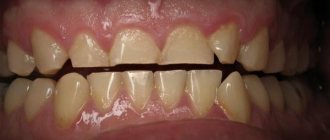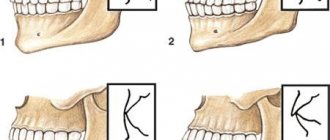Wisdom or 8 teeth can cause a lot of problems, especially if they grow into the cheek. These teeth have no analogues in the primary occlusion, so they erupt through unprepared periodontal tissue, and their growth is accompanied by discomfort even with proper eruption. The growth of eighth teeth can begin at age 17, but there are cases when these teeth remain impacted (not erupted) throughout life.
Symptoms and signs of abnormal growth
It is extremely rare for eights to appear without any complications. This is due, first of all, to the fact that wisdom teeth grow in adulthood, when the jaw is already formed. Even with proper teething, discomfort may still be present for several weeks or months. If a wisdom tooth grows incorrectly or has an abnormal location, then certain symptoms indicate this.
Let's take a closer look at the types of pathologies and symptoms associated with the growth of wisdom teeth.
- Retention is a pathology in which the third molar is located under the mucous or bone tissue. The main symptoms are severe pain in the gums, as well as the development of an inflammatory process in the gum pocket.
- Dystopia or abnormal position of the tooth. It manifests itself as severe pain, affecting adjacent teeth, and the development of inflammation, including phlegmon or osteomyelitis.
The initial alarming symptoms that a patient may identify when a wisdom tooth grows are:
- Swelling in the cheek area.
- When swallowing, severe pain occurs, radiating to the throat or ear.
- Purulent or bloody discharge.
- Injury to the mucous membrane.
If you detect at least one of the above symptoms during the eruption of figure eights, you must seek the help of a dentist as soon as possible. The doctor will conduct an x-ray and determine whether the wisdom tooth is growing correctly.
Complications of wisdom teeth eruption
| Type of pathology | Description |
| Dystopia | Incorrect position of the tooth. When a wisdom tooth comes through, it hurts much more than usual. It can push against neighboring teeth, causing them harm. |
| Retention | The tooth is completely or partially hidden in soft tissue or even bone. When a wisdom tooth erupts, the gums hurt and pericoronoritis may develop (inflammation caused by the activity of bacteria that accumulate in the gum hood). |
| Mixed pathology (retention + dystopia) | Incorrect position is complicated by tooth retention. The most severe pathology that provokes the occurrence of phlegmon, abscesses and osteomyelitis. |
Symptoms of the eruption of wisdom teeth in adults with suspected development of pathology:
- when a wisdom tooth erupts, the cheek becomes swollen;
- blood and pus are released when a wisdom tooth erupts;
- severe pain in the gums and jaw when wisdom teeth erupt;
- injury to the cheeks and tongue.
What to do with a bothersome wisdom tooth at home
The most important thing is not to cause further harm to yourself before visiting the dentist. It is extremely important to avoid overheating the area of concern. Heat can accelerate the onset of the inflammatory process. Therefore, you should not apply warm compresses or take a hot bath.
What can you do to relieve pain when wisdom teeth erupt:
- follow a gentle diet (do not eat very hard, hot or cold foods);
- after eating, rinse your mouth;
- use local anesthesia, such as gels used during teething in children;
- In case of severe pain, you can take painkillers.
But the most important thing is not to delay your visit to a specialist! Only he will be able to determine the seriousness of the problem and help avoid possible complications.
What is dangerous about malocclusion?
Violations of occlusion entail diverse consequences from gastrointestinal disorders to psychological complexes. If you are already thinking about correcting your bite, you are most likely familiar with its consequences firsthand. It is also worth noting that malocclusion often provokes premature tooth decay, as it is often the cause of pathological abrasion of teeth, the development of caries and periodontitis. In addition, the pathology can lead to overload of the temporomandibular joint, when the patient replaces clicks and crunches when opening and closing the mouth.
Removal of abnormally growing eighth tooth
Very often, if the third molar grows abnormally, it is necessary to resort to its removal. Indications for surgery:
- Repeated cases of pericoronitis (purulent formation in the gum pocket). This problem most often occurs on the lower eights, which have not completely erupted. Pericoronitis is usually treated by removing the overhanging gum, but if the disease recurs, it is recommended to remove the offending tooth.
- The upper eight grows into the cheek, constantly injuring it. To avoid the formation of ulcers and infection of the oral cavity, as well as to prevent pain, wisdom tooth removal is required.
- The development of wisdom tooth dystopia was diagnosed. The tooth grows at an incorrect angle, which can lead to inflammation of the periodontal tissues and the development of caries on the eighth and neighboring teeth.
- The wisdom tooth grows to the side and affects the ternary nerve, causing attacks of pain. Most often, this occurs when an unerupted figure eight rests on the roots of neighboring teeth. Such an anomaly can only be diagnosed using an x-ray.
The procedure for performing the manipulation may differ depending on the location of the tooth. The sequence of the procedure during surgery:
- antiseptic treatment of the operating area;
- administration of anesthetic;
- tooth extraction;
- inserting a gauze swab into the hole to eliminate bleeding.
The tampon should be removed from the wound no earlier than after 25 minutes. The tampon must be in the socket to prevent bleeding. After the operation, the dental surgeon gives recommendations that must be strictly followed.
Non-inflammatory pain syndrome -
If the pain syndrome is not associated with the development of inflammation, but is the result of pressure from the wisdom tooth on the teeth in front, this is an indication for taking analgesics from the NSAID group, for example, based on ibuprofen. Of course, there are also pain-relieving gels for topical use (Cholisal, Kamistad, etc.), but the effect of their use in this case will not be long or pronounced. Again, in this case, we recommend contacting a dentist (24stoma.ru).
If the wisdom tooth does not have enough space to erupt, it can cause displacement of the teeth in front, which will lead to crowding of the front teeth. The second variant of the problem is that the pressure of the wisdom tooth when erupting on the 7th tooth can lead to the destruction of the crown of the latter. Therefore, if pain occurs during teething, it is better to immediately assess the need to preserve the wisdom tooth, and in some cases it is better to remove it immediately.
→ Indications for saving the eighth teeth
Complications of wisdom tooth eruption –
- Crowded teeth – if there is not enough space for the erupting wisdom teeth, the latter begin to shift the remaining teeth towards the central incisors, causing crowding of the teeth in the frontal area of the dentition. Therefore, it is very important to assess in advance whether the length of the body of the lower jaw is sufficient for the eruption of the eighth teeth. If there is not enough space, it is better to remove these teeth preventively, otherwise you will likely need orthodontic treatment in the future.
- Destruction of the tooth in front - wisdom teeth often erupt in such a way that they have an inclined position, resting the front tubercles of the crown on the seventh tooth in front.
Constant, prolonged pressure will eventually cause the enamel and dentin to break down. As can be seen in Fig. 7, the seventh molar has a darkening in the crown area, which corresponds to the area of tooth destruction. Preservation of the seventh tooth and its full treatment in this case is impossible without removing the wisdom tooth. Figure 8 shows the same picture - number (1) shows a small area of destruction of the hard tissues of the seventh tooth, and number (2) shows the area of bone tissue destruction. In Fig. 9 you can see significant destruction of the coronal part of the seventh tooth (the area of destruction looks like a dark spot against the background of the crown, and is limited by white arrows). At the same time, the amount of destruction of the crown of the 7th tooth indicates that it must be removed.
How to ease the eruption of wisdom teeth -
If the crown of the wisdom tooth is already close to the surface of the gum, then to speed up eruption and reduce symptoms, the gum above the crown of the wisdom tooth is usually excised. That is, they make a so-called “window”. The decision about the possibility of such an intervention should be made by the dentist, taking into account the X-ray data.
In some cases, pain-relieving gels for the oral mucosa can also be recommended, for example:
- Cholisal-gel applications,
- Kamistad gel applications.
Is it necessary to remove a tooth that has not erupted?
If an un-erupted figure eight does not cause a person any discomfort and there are no indications for its removal, then the operation is not necessary. However, if this unit, being in a bud state inside the gum cavity, in any way interferes with the patient’s normal life, the doctor may recommend its removal.
The main indications include: pain over a long period of time, the appearance of cysts, purulent foci of inflammation, for example, osteomyelitis or sinusitis, incorrect direction of growth, partial retention and much more. Also, quite often, an unerupted tooth needs to be removed before starting orthodontic treatment in order to correct a malocclusion.
It is important to understand that if not a single wisdom tooth has erupted and the person does not experience the slightest discomfort, then nothing needs to be done. If the eight does not interfere with the normal development of adjacent units and does not affect the standard of living, then it can be left in its place. However, if unerupted teeth cause pain, the doctor may insist on their urgent extraction.
previous post
Why can all teeth hurt at the same time?
next entry
At what age should correction begin?
Orthodontic correction can begin at the age of 6-8 years, but at this time only removable appliances such as plates are used. Braces can be installed only after all permanent teeth have erupted. This process is usually completed by age 14. Today, you can also correct your bite using clear aligners. They are used from 16-18 years of age. It is important here that the teenager understands the importance of treatment and is motivated to complete it, aware of the importance of what is happening. Since the aligners are easy to remove, parents need to be sure that the child is actually wearing them for the required amount of time. Otherwise, it will be impossible to achieve a positive result.
Correcting overbite with braces in adults
Many people are concerned about the question: can teeth straighten themselves? As already mentioned, the process of jaw transformation ends at the age of 14 years. Teeth can also shift when third molars (wisdom teeth) erupt, which usually occurs between the ages of 18 and 25. However, in such a situation one cannot expect positive changes. In the future, the position of the teeth does not change.
For such serious disorders as progenia, prognathia, and significant crowding of teeth, treatment with a permanent brace system is indicated. Today, patients have the opportunity to choose a system made of metal, synthetic sapphire, and ceramics. The products are characterized by high aesthetics, are suitable for long-term treatment and allow you to achieve expressive aesthetic results.
How to straighten your front teeth
Aligners are best suited for straightening frontal teeth. They allow for easy rotation, extrusion, intrusion and tooth movement. They can also help eliminate crowding. To do this, teeth are separated - a small amount of enamel is removed in the proximal area (between the teeth). Due to the freed up space, the teeth are moved. Separation is a safe and painless procedure. Activators help speed up the alignment process - small composite “dots” that the doctor forms on the surface of the teeth. They serve as additional support for the system, but at the same time do not interfere with the aesthetics of the smile.
Indications for removal
Wisdom teeth removal is carried out if the following indications are present:
- Horizontal growth of the molar (promotes displacement of teeth in a row);
- the figure eight occupies an anatomically incorrect position and harms neighboring units;
- incomplete eruption (impacted tooth);
- pulpitis, periodontitis;
- impossibility or inappropriateness of endodontic treatment.
If the wisdom tooth on top hurts, it is easier to remove it than the lower third molar. The lower eights are distinguished by large, developed, often tangled roots, and the mandibular bone itself has a more dense structure. The complexity of surgical extraction depends on:
- Wisdom tooth positions;
- the position of neighboring units that complicate extraction;
- degree of eruption;
- the number of roots, their confusion.
An orthopantomogram gives the doctor the necessary information about the position of the figure eight and its condition.
